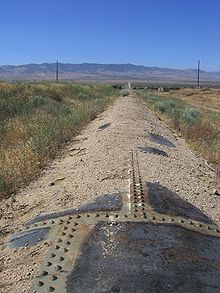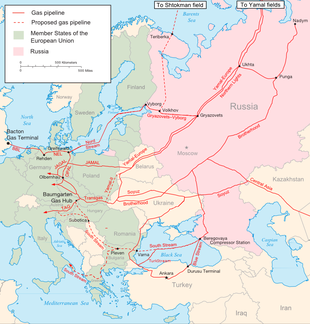A "
Pig" launcher/receiver, belonging to the natural gas pipeline in Switzerland
It is uncertain when the first
crude oil pipeline was built. Credit for the development of pipeline transport is disputed, with competing claims for
Vladimir Shukhov and the
Branobel
company in the late 19th century, and the Oil Transport Association,
which first constructed a 2-inch (51 mm) wrought iron pipeline over a
6-mile (9.7 km) track from an oil field in Pennsylvania to a railroad
station in
Oil Creek, in the 1860s. Pipelines are generally the most economical way to transport large quantities of oil,
refined oil products or
natural gas over land.
Natural gas (and similar gaseous fuels) are lightly pressurized into
liquids knows as Natural Gas Liquids (NGLs). Small NGL processing
facilities can be located in oil fields so the butane and propane liquid
under light pressure of 125 pounds per square inch (860 kPa), can be
shipped by rail, truck or pipeline. Propane can be used as a fuel in oil
fields to heat various facilities used by the oil drillers or equipment
and trucks used in the oil patch. EG: Propane will convert from a gas
to a liquid under light pressure, 100 psi, give or take depending on
temperature, and is pumped into cars and trucks at less than 125 psi
(860 kPa) at retail stations. Pipelines and rail cars use about double
that pressure to pump at 250 psi (1,700 kPa).
The distance to ship propane to markets is much shorter, as thousands of
natural-gas processing plants are located in or near oil fields. Many
Bakken Basin
oil companies in North Dakota, Montana, Manitoba and Saskatchewan gas
fields separate the NGLs in the field, allowing the drillers to sell
propane directly to small wholesalers, eliminating the large refinery
control of product and prices for propane or butane.
The most recent major pipeline to start operating in North America,
is a TransCanada natural gas line going north across the Niagara region
bridges with Marcellus shale gas from Pennsylvania and others tied in
methane or natural gas sources, into the Canadian province of Ontario as
of the fall of 2012, supplying 16 percent of all the natural gas used
in Ontario.
Major Russian gas pipelines to Europe in 2009
This new US supplied natural gas displaces the natural gas formerly
shipped to Ontario from western Canada in Alberta and Manitoba, thus
dropping the government regulated pipeline shipping charges because of
the significantly shorter distance from gas source to consumer. Compared
to shipping by
railroad,
pipelines have lower cost per unit and higher capacity. Pipelines are
preferable to transportation by truck for a number of reasons.
Employment on completed pipelines represents only "1% of that of the
trucking industry."
[3]
To avoid delays and US government regulation, many small, medium and
large oil producers in North Dakota have decided to run an oil pipeline
north to Canada to meet up with a Canadian oil pipeline shipping oil
from west to east. This allows the Bakken Basin and Three Forks oil
producers to get higher negotiated prices for their oil because they
will not be restricted to just one wholesale market in the US. The
distance from the biggest oil patch in North Dakota, is
Williston, North Dakota, only about 85 miles or 137 kilometers to the Canada–US border and
Manitoba.
Mutual funds and
joint ventures are big investors in new oil and gas pipelines. In the fall of 2012, the US began exporting
propane
to Europe, known as LPG, as wholesale prices there are much higher than
in North America. Additionally, a pipeline is currently being
constructed from North Dakota to Illinois, commonly known as the
Dakota Access Pipeline.
As more North American pipelines are built, even more exports of LNG,
propane, butane, and other natural gas products occur on all three US
coasts. To give insight, North Dakota Bakken region's oil production has
grown by 600% from 2007 to 2015.
[4]
North Dakota oil companies are shipping huge amounts of oil by tanker
rail car as they can direct the oil to the market that gives the best
price, and rail cars can be used to avoid a congested oil pipeline to
get the oil to a different pipeline in order to get the oil to market
faster or to a different less busy oil refinery. However, pipelines
provide a cheaper means to transport by volume.
Enbridge in Canada is applying to reverse an oil pipeline going from
east-to-west (Line 9) and expanding it and using it to ship western
Canadian bitumen oil eastward.
[5]
From a presently rated 250,000 barrels equivalent per day pipeline, it
will be expanded to between one million to 1.3 million barrels per day.
It will bring western oil to refineries in Ontario, Michigan, Ohio,
Pennsylvania, Quebec and New York by early 2014. New Brunswick will also
refine some of this western Canadian crude and export some crude and
refined oil to Europe from its deep water oil ULCC loading port.
Although pipelines can be built under the sea, that process is
economically and technically demanding, so the majority of oil at sea is
transported by
tanker ships.
The Enbridge
Sandpiper pipeline
is proposed to transfer valuable oil from Western North Dakota through
northwestern Minnesota. The pipeline will be 24-30 inches in diameter.
It will carry over 300,000 barrels of oil a day with a volatility of 32.
[6]
Growth of market
Gas pipe in the dry region of Antofagasta, Chile.
The market size for oil and gas pipeline construction experienced
tremendous growth prior to the economic downturn in 2008. After
faltering in 2009, demand for pipeline expansion and updating increased
the following year as energy production grew.
[7] By 2012, almost 32,000 miles of North American pipeline were being planned or under construction.
[8]
Construction and operation
Oil pipelines are made from
steel or
plastic
tubes with inner diameter typically from 4 to 48 inches (100 to
1,220 mm). Most pipelines are typically buried at a depth of about 3 to 6
feet (0.91 to 1.83 m). To protect pipes from
impact,
abrasion, and
corrosion, a variety of methods are used. These can include
wood lagging (wood slats),
concrete coating, rockshield,
high-density polyethylene, imported sand padding, and padding machines.
[9]
Crude oil contains varying amounts of
paraffin wax and in colder climates wax buildup may occur within a pipeline. Often these pipelines are inspected and cleaned using
pigging,
the practice of using devices known as "pigs" to perform various
maintenance operations on a pipeline. The devices are also known as
"scrapers" or "Go-devils". "Smart pigs" (also known as "intelligent" or
"intelligence" pigs) are used to detect anomalies in the pipe such as
dents, metal loss caused by corrosion, cracking or other mechanical
damage.
[10]
These devices are launched from pig-launcher stations and travel
through the pipeline to be received at any other station down-stream,
either cleaning wax deposits and material that may have accumulated
inside the line or inspecting and recording the condition of the line.
For natural gas, pipelines are constructed of carbon steel and vary
in size from 2 to 60 inches (51 to 1,524 mm) in diameter, depending on
the type of pipeline. The gas is pressurized by compressor stations and
is odorless unless mixed with a
mercaptan odorant where required by a regulating authority.








